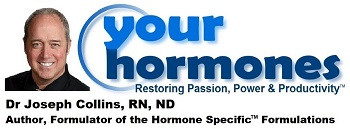
Choose Lab Tests Wisely by Joseph J Collins, RN, ND
On one hand we are faced with traditional serum testing that is often done incompletely – lacking SHBG assessment for sex hormones, or just testing TSH for thyroid function. In that situation we struggle to advance diagnostic medicine to be comprehensive enough to have value based on new science. It is a case of tradition trumping science.
On the other hand, we are faced with salivary testing that is done improperly. Saliva hormone testing is aggressively marketed without full disclosure of the science which reveals its’ limitations such as single day assessment of sex hormones being clinically invalid. It is a case of marketing trumping science.
Knowing the limitations of lab tests allows us to make the required adjustments to overcome those limitations. Both serum and saliva can be done correctly – and can yield information that can be gained by no other means.
If Using Salivary Hormone Tests, Measure Hormones on Multiple Days
Single hormone assessment is not an accurate demonstration of your hormonal patterns, which fluctuate from day to day. Saliva hormones, fluctuate from day to day. Realizing that saliva assays exhibit hormone concentrations at the tissue level at a given point in time [1], we can recognize that making a decision about hormone levels based on one saliva sample is not a valid decision.
Previous research, and clinical experience, has revealed that reliability can be increased by using more than one measurement [2]. The best way to evaluate hormone levels during and after menopause is through the collection and testing of at least three samples, so that fluctuations can be evaluated. Multiple-sample assessment is required because unstable hormonal fluctuations have been observed years after menopause [3]. These hormonal fluctuations play a role in many of the symptoms and problems associated with menopause including migraine headaches, obesity, mood changes, and bleeding irregularities in both perimenopause and postmenopause women [4,5,6,7].
If Using Serum Hormone Tests
If using serum hormone tests it is important to always measure SHBG when measuring sex hormones in both men and women. Without SHBG there is no information on the affect that estrogens have on this very important serum protein. If SHBG is too high, it can interfere with testosterone function in both men and women. If too low, it can increase risk of cancers.
Cortisol and DHEA-S should be added if there is suspicion of adrenal fatigue or adrenal stress. Androstanediol glucuronide is helpful in evaluation of either PCOS in women or prostate hyperplasia in men. The testing of 17-hydroxyprogestone is also valuable in PCOS evaluation.
For thyroid evaluation, TSH is not an accurate marker of thyroid function. T3 and T4 are actual measurements of thyroid hormones. Reverse T3 should be added if the patient is showing signs of hypothyroidism, even though their T3 & T4 are normal. Reverse T3 (which is a T3 antagonist) is elevated in liver disease, toxin. poisoning, stress, fever/chronic infection, fasting, severe dietary restriction and malabsorption. It is also important to measure anti-TG and anti-TPO. If any of those antibodies are elevated, then thyroid function can be suppressed, even with normal T3 & T4 levels.
Here is a list of profiles that give the best indication of hormone levels:
Here is a list of profiles that give the best indication of hormone levels:
Female Hormone Profile: Estradiol, Estrone, Testosterone, Progesterone, SHBG (add Cortisol & DHEA if adrenal fatigue is suspected) – (add Cortisol, DHEA-S, DHT, androstanediol glucuronide & 17-hydroxyprogestone if PCOS or PCO-like syndrome is suspected)
Male Hormone Profile: Testosterone, DHT, Estradiol, Estrone, Progesterone, SHBG (add Cortisol & DHEA if adrenal fatigue is suspected) – (add Cortisol, DHEA-S & androstanediol glucuronide if prostate hyperplasia is suspected). Also measure and monitor PSA levels.
Thyroid Profile: TSH, T3, T4, anti-TPO, anti-TG (add rT3 if toxin/liver, stress, fever/chronic infection, fasting/dietary restriction/malabsorption
Next: Proper Use of of BHRT
Salivary Hormone Test References:
[1] Riad-Fahmy D, Read GF, Walker RF. Salivary steroid assays for assessing variation in endocrine activity. J Steroid Biochem. 1983 Jul;19(1A):265-72. PubMed PMID: 6887863.
[2] Dabbs JM. Salivary Testosterone Measurements: Reliability Across Hours, Days and Weeks. Physiology & Behavior, 1990. Vol. 48. pp83-86. PubMed PMID: 2236282.
[3] Overlie I, Moen MH, Morkrid L, Skjaeraasen JS, Holte A. The endocrine transition around menopause--a five years prospective study with profiles of gonadotropines, estrogens, androgens and SHBG among healthy women. Acta Obstet Gynecol Scand 1999 Aug;78(7):642-7. PubMed PMID: 10422913.
[4] Fettes I. Migraine in the menopause. Neurology 1999;53(4 Suppl 1):S29-33. PMID: 10487511.
[5] Lovejoy JC. The influence of sex hormones on obesity across the female life span. J Womens Health 1998 Dec;7(10):1247-56. PubMed PMID: 9929857.
[6] Vliet EL, Davis VL. New perspectives on the relationship of hormone changes to affective disorders in the perimenopause. NAACOGS Clin Issu Perinat Womens Health Nurs 1991;2(4):453-71. PubMed PMID: 1772732.
[7] Johannes CB, Crawford. SL Menstrual bleeding, hormones, and the menopausal transition. Semin Reprod Endocrinol 1999;17(4):299-309. PubMed PMID: 10851570.
